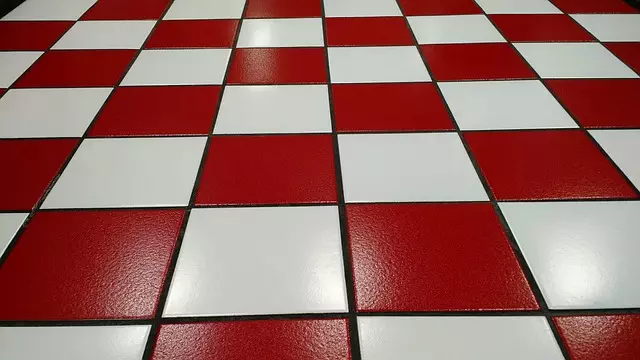Grout stain removal presents a challenge due to grout lines' intricate nature, trapping dirt and substances. Causes include wear & tear, spills, food particles, improper cleaning, and poor installation. Effective removal requires identifying the stain source and using appropriate tools & materials, such as high-quality grout cleaners, brushes, or pressure washers. Strategies range from mild solutions with soft-bristled brushes to baking soda pastes and commercial products for severe cases. Preventive measures include regular cleaning, sealing every 6-12 months, and professional services for stubborn stains. Balancing potency and safety is key when selecting grout stain removal cleaners based on surface types.
Professional grout stain cleaning is a crucial task that can transform your space. Understanding the causes of grout stains empowers effective removal and prevention. This comprehensive guide delves into the intricacies of grout stain cleanup, offering insights on tools, materials, step-by-step processes, and common mistakes to avoid. Learn how to choose the right cleaner for diverse surfaces while exploring professional assistance options, ensuring a sparkling, stain-free space. Discover expert tips for preventing future stains, enhancing your home or commercial setting’s overall aesthetics.
Understanding Grout Stain Causes

Grout stain removal is a common concern for many homeowners due to the intricate nature of grout lines, which can trap dirt, grime, and various substances, leading to unsightly stains. Understanding the causes behind these stains is the first step towards effective grout stain cleaning. Many factors contribute to grout discoloration, including regular wear and tear from foot traffic, spills of acidic or colored beverages, food particles, and even certain types of cleaning products.
Over time, these contaminants build up in the tiny crevices, causing a range of stains, from light discoloration to deep, stubborn marks. Additionally, poor sealing or improper grout installation can exacerbate the issue. Once you identify the source of the stain, you can choose the most suitable grout stain removal method, ensuring a fresh and clean look for your tiling.
Tools and Materials for Effective Cleaning

When tackling grout stain removal, the right tools and materials are essential for achieving optimal results. Start with a good quality grout cleaner, which can be in the form of a liquid or powder. These cleaners often contain powerful enzymes or acids that effectively break down and remove stubborn stains. Always follow the manufacturer’s instructions for safe and effective use.
Additionally, invest in a sturdy brush designed for grout cleaning, preferably with stiff bristles to agitate and scrub away dirt and grime. A vacuum cleaner with a specialized attachment can also be useful for suctioning out loose debris before applying the cleaner. For more severe cases, a pressure washer might be needed, but exercise caution to avoid damaging the grout or surrounding tiles.
Step-by-Step Guide to Grout Stain Removal

Removing grout stains is a process that, when done correctly, can restore the cleanliness and aesthetics of your tiled surfaces. Start by identifying the type of stain and gathering the necessary supplies. For mild stains, a mixture of warm water and a mild detergent or vinegar is often effective. Begin by applying the solution to the stained area using a soft-bristled brush or cloth. Gently scrub the stain in a back-and-forth motion, ensuring you don’t spread it further. Rinse thoroughly with clean water afterward.
For more persistent stains, consider using specialized grout cleaning products available at hardware stores. Follow the manufacturer’s instructions for application and safety precautions. After allowing the product to sit for the recommended time, scrub gently and rinse. For heavily soiled or discolored grouts, a mixture of baking soda and water can create a powerful cleaning paste. Apply this paste over the stain, let it sit for several minutes, then scrub away the residue with a damp cloth or sponge.
Common Mistakes to Avoid During Cleaning

When tackling grout stain removal, it’s easy to make mistakes that can hinder your cleaning efforts or even cause further damage. One common blunder is using harsh chemicals without proper protection, which can not only be dangerous but also ineffective on set-in stains. Always wear protective gear, including gloves and goggles, when handling chemical cleaners. Additionally, many people rush the process, not allowing enough time for soaking or agitating the cleaner into the grout. Properly saturating the stained area is crucial for effective stain removal.
Another mistake to avoid is using the wrong tools or techniques. Using a stiff brush on delicate grout can cause scratching or tearing of the grout lines. Opt for soft-bristled tools or even specialized grout cleaning tools designed for intricate spaces. Overlooking spot treatments is also a common pitfall; stains often require persistent effort, and skipping spots can leave behind unsightly marks. Regularly inspect your work area and reapply cleaner as needed to ensure every stain is addressed effectively.
Preventing Future Stains

After successfully removing grout stains, preventing future occurrences is key. Regular cleaning and maintenance can significantly extend the lifespan of your grout and tile surfaces. Start by sweeping or vacuuming your floors frequently to eliminate loose dirt and debris, which are primary stain causes. Moist mopping with a mild detergent is also effective in capturing embedded particles before they set into the grout.
Additionally, sealing your grout once every 6-12 months creates an impenetrable barrier against stains. Sealing agents fill in pores, preventing liquids from absorbing into the grout. Always follow the manufacturer’s instructions for proper application to ensure optimal protection. Regularly checking and reapplying sealant as needed is crucial for maintaining a stain-free grout environment.
When to Seek Professional Help

If your grout stain removal efforts have been fruitless, it might be time to call in the professionals. Grout, especially in high-traffic areas like kitchens and bathrooms, is prone to staining from various sources—molds, mildew, hard water stains, and even food particles. While DIY methods can offer temporary solutions, deep-seated stains often require specialized equipment and expertise.
Professional grout cleaning services employ advanced techniques and eco-friendly products to effectively eliminate stubborn stains. They understand the importance of proper preparation, protection of surrounding surfaces, and precise application of cleaning agents. If your grout looks beyond repair or if you’re dealing with a complex stain that won’t budge, seeking professional help ensures a thorough clean that restores the aesthetic appeal and longevity of your grouted spaces.
Choosing the Right Grout Cleaner for Different Surfaces

When it comes to grout stain removal, selecting the appropriate cleaner is key, especially considering the diverse range of surfaces in your home or commercial space. Different grout types and materials require specific cleaning approaches. For instance, porous stones like marble or travertine necessitate a gentle yet effective cleaner to avoid damage, while non-porous surfaces like ceramic tile can withstand stronger solutions.
Choosing the right cleaner means balancing potency with safety. Enamelled or glazed tiles might require more aggressive stain removers due to their harder surface, whereas natural stones demand pH-neutral or acid-free options to preserve their finish. Always read product labels and follow instructions to ensure optimal grout stain removal without compromising the integrity of your surfaces.
